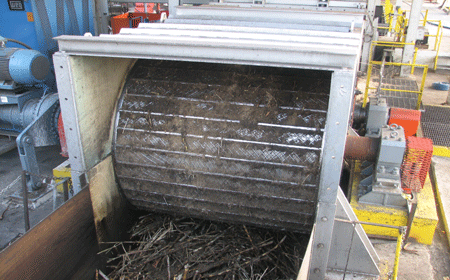TOWER HILL, Orange Walk, Wed. Aug. 5, 2015–Belizario Carballo, Chief Financial Officer of the Belize Sugar Industries (BSI), has indicated to Amandala that this year has proven to be “a record for as long as we have been in the sugar business…” in more ways than one.
BSI is projecting that roughly BZ$25 million will be paid out to cañeros next week, based on a total crop value of an estimated BZ$82 million and a record second payment, adding to the gains they will receive for a better-quality cane crop this year.
Carballo confirmed that not only is there going to be a record second payment for sugar, but the industry also produced a record amount of sugar—shattering the record 125,000 set in 1997. Last year, 123,000 tons of sugar was produced.
According to Carballo, there are about roughly 27,000 tons of bulk sugar and 10,000 tons of bagged sugar in storage, as well as roughly 10,000 tons of molasses in the store.
Farmers, who receive payments in three installments, get 65% of what is termed the net strip value, which is derived from a formula that considers the expenses incurred in the production, distribution and sale of sugar on both the local and export markets.

Carballo said that BSI had a contract for sale of sugar to the EU which had prices locked in for three years at a minimum of 425 euros, but prices are now trading on the EU open market at 100 euros lower today.
“For some time, we struggled with cane supply being down, and it was a bit of ups and downs. This year, we really had a good combination of cane quality [as well],” he said, adding that it had also reached a record of 8.35, which is the amount of cane it took to make one ton of sugar – much more efficient than the tons cane per tons sugar (TCTS) of 9.66 reported for the previous crop year.
Carballo told us that despite the late start in the crop year, which commenced late in January for a second consecutive year, they have milled almost the same amount of sugar as last year, minus about 60,000 tons.
This year, BSI milled 1,186,000 tons of cane. Carballo explained that the first payment for the cane delivered is made during the week of delivery, and that payment was roughly 80% of first estimated price ($53.55) or $42.84. Since the new price is quoted at $70.45, farmers should receive what amounts to 91% of that, or roughly $64 per ton of cane. They received $42.84 at first delivery, and the balance due, on average, is $21.27. The remainder to make up 100% of payments is due in the first week in November.
While the average second payment to be issued next week amounts to $21.27, farmers, who were assigned to 19 test groups, will receive varying payments based on the quality of the cane delivered.
This means that farmers belonging to the newly formed Progressive Sugar Cane Producers Association (PSCPA), from the areas of Patchakan Village and Louisville in the Corozal District, and San Lazaro and Douglas Villages in Orange Walk, will receive the highest payment at $23.41. The lowest second payment to farmers will be $19.23 per ton of cane delivered.
In addition to receiving payment for sugar, farmers will also receive payment for bagasse, under the co-generation franchise operated by BSI.
Those payments, said Carballo, are also expected to be higher than the $597,000 paid to farmers last year.
However, the Chief Financial Officer cautioned that beyond this crop, the industry will become more exposed to world market prices, which are already showing a dip of about 30%, signaling that there are going to be some financial challenges on the road ahead.
“It is not as if everything is nice and rosy in sugar land,” Carballo said.
Carballo noted that the landscape of the sugar market has been changing and a price fall-off is anticipated next year.
Currently, the vast majority of Belize’s sugar export goes to the EU, although some is sold to the US market.
“Generally, we sell wherever we can get the best price. [The EU] has traditionally been the place where we get the best price but that might change,” he said, adding that the EU, nonetheless, is likely to continue to offer some premium for Belize sugar.
According to Carballo, market changes were anticipated for October 1, 2017, when EU beet production restrictions are due to be lifted, triggering an increase in production of sugar derived from beet in that jurisdiction – which would, in turn, have an adverse impact on market prices. However, he noted that price changes anticipated then are already coming on the horizon, perhaps due simply to supply and demand factors.
The industry urgently needs to craft a strategic development plan, but they are behind time, Carballo said.
The development of that plan rests in the hands of a multi-sectoral, industry-led committee, dubbed the Strategic Development Plan Steering Committee, which met last week. That group, said Carballo, is headed by Jose Alpuche, the chief executive officer in the Ministry of Agriculture.
Although farmers were calling for a further extension in the crop beyond Sunday, July 12, Carballo said that BSI could not extend the season any further because it must undertake factory maintenance and complete $7 million worth of capital projects before the new crop year—which he hopes will begin on time this December.
He said that there are 4 projects planned for the coming months: the installation of (1) a new cane dumper, which would bolster its offloading facility to move cane from the delivery trucks; (2) a new cane yard control cabin, to improve the feeding of cane into the mill from the offloading points; (3) two additional cane juice heaters, which will add clarification capacity to the mill; and (4) a new bagging line to enhance their ability to bag more sugar in 25 or 50-kg bags.

